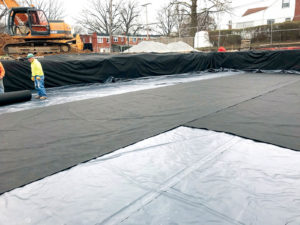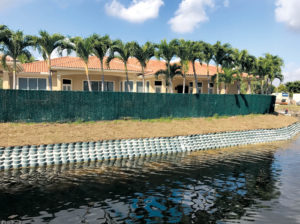
As more land is lost to urban sprawl, and managing stormwater and wastewater runoff from hard-surface pavements has become a growing necessity, green infrastructure strategies are front and center in the minds of city planners, engineers and others focused on environmental and quality-of-life issues.
Green infrastructure (GI) is a sustainable, low-cost and environmentally friendly approach to water management that uses both natural and engineered systems—including vegetation, soils, paving and gravel systems, and textiles/geosynthetics. The goal is to facilitate water infiltration into soil, divert it into waterways, and prevent contamination of either the water or the surrounding environment.
“Green infrastructure is widely used and is getting more attention every day,” says Corey Simonpietri, director of stormwater management for ACF Environmental, a Richmond, Va., supplier of geosynthetic technologies for use in roads, landfills and commercial/residential site development. The company’s product line includes erosion control materials, inlet protection devices and stormwater management systems.
“There are billions of dollars flowing into these projects across the country,” he says. “Cities love GI systems because they can do the things they’re required to do, like mitigate combined sewer overflows or reduce pollutants flowing to natural waterways, while beautifying the city.”
Extreme weather events and flooding are increasing the popularity of GI systems because they offer low-impact ways to control water runoff, says Bill Handlos, director of Presto Geosystems, located in Appleton, Wis. The company manufactures construction products made from virgin and recycled high-density polyethylene (HDPE).

“Regulations limiting hard pavements for new or reconstructed areas are also turning stormwater professionals and landscape designers to solutions to help limit runoff,” Handlos explains. “These regulations come about due to increased flooding caused by the high percentage of impervious areas that already exist in urban areas.”
The social pressure to adopt sound environmental and habitat practices is being felt by governments and developers and is fueling interest in these strategies, says Ross Bruno, business development specialist for East Coast Erosion Control, a Bernville, Pa., manufacturer and distributor of erosion control products. Costs are another factor, he says, because it’s far more expensive to restore water quality than it is to maintain and protect it.
Role of geosynthetics
As urbanization continues chewing up undeveloped land, increasing the amount of paved areas, runoff volumes will escalate, says Felon Wilson, business director of geomembrane products for Seaman Corp. Headquartered in Wooster, Ohio, the company manufactures industrial coated fabrics used worldwide for municipal, commercial and industrial applications.
“The quality of runoff may worsen except when kept in check,” he says. “By retaining runoff closer to the source, the natural water cycle is more closely mimicked. Geosynthetics allow a designer to control land features in unique ways that are effective while being reasonable in cost.”

Geosynthetics are synthetic (usually polymeric) products that can be roughly divided into eight categories: geotextiles, geogrids, geonets, geomembranes, geosynthetic clay liners, geofoam, geocells and geocomposites.
“In general, geosynthetics are being used to eliminate the contaminant-collecting tendency of traditional remedies such as riprap,” Bruno explains. “They’re also being used to decelerate runoff at the point of impact or to maintain runoff rate and retain stormwater on-site; or to integrate microscale controls that infiltrate, evaporate, store and manage runoff close to the source.”
According to Bruno, market growth for geosynthetics is surging, with independent studies forecasting growth of up to 25 percent over the next several years. He attributes some of this activity to increased adoption rates within traditional market areas for geosynthetics, but says a bigger part of it is due to early adoption in regions that have not typically used geosynthetics.
“Erosion control isn’t solely a problem experienced in coastal regions,” he explains. “Drought-prone areas are also utilizing geosynthetics to better retain water resources in the region. And agricultural runoff is spreading ag bioproducts to habitats that are sensitive to such impacts. As regional challenges are better understood, best practices and adoption of geosynthetics is accelerating.”
In addition to erosion control and slope stabilization, uses for geosynthetics include green pavement (grassy pavers), green roofing and pavement reinforcement, says Chad Lipscomb, technical lead and vice president of market development for Western Excelsior Corporation (WEC) and North American Green (NAG). Headquartered in Evansville, Ind., WEC/NAG produces rolled erosion control products (RECPs) and hydraulically applied erosion control products (HECPs).
“To some degree, pond liners and the like could also be considered part of the green infrastructure-geosynthetic landscape, as the net effect is useful water and pollution management,” Lipscomb adds.
Although he sees market growth for geosynthetics, Lipscomb describes activity as “ebb and flow,” thanks to considerations such as government/city budgets, weather impacts on construction projects and the adoption of green policies. The latter, along with an aging infrastructure system in need of repair, positions geosynthetics for a bright future, he says. Lipscomb expects additional momentum with the continued development of credits toward carbon capture and carbon sequestration.
Products and projects

Some GI projects are intended to capture urban stormwater runoff, infiltrating it as much as possible, Simonpietri explains. Textiles used for the outer envelope of these systems and components must resist clogging, which is addressed by the company’s ACF M200 product, a woven monofilament geotextile.
For GI projects where infiltration is affected by poor soils, karst or groundwater contamination, the goal is to remove pollutants from the runoff and extend the time of concentration.
“For these projects we wrap green infrastructure systems in 20- or 30-mil PVC geomembrane. The PVC material is very easy to work with in the field for seams, pipe outlet connections and when dealing with unexpected utility conflicts,” Simonpietri says.
East Coast Erosion Control’s products are primarily used for industrial applications, such as oil pipeline construction and maintenance and mining, and for large-scale residential development and retail district construction projects. The company offers a variety of turf reinforcement mats (TRMs), designed for immediate erosion control protection, and high-performance turf reinforcement mats (HPTRMs), a more permanent version of the TRMs.
The company’s HPTRM product T-RECS has a cross-directional monofilament structure woven into a dome shape for greater surface coverage, improved soil adherence, the establishment of vegetation and a strong root system. It’s designed to absorb the impact from high-channel flow velocities, waves, wind and ice.
“Engineers are finding T-RECS more cost-effective than riprap and much gentler on the environment,” says Bruno. “Most recently, we’ve seen T-RECS being used to reinforce levees from the impacts of catastrophic storms and storm surges.”
Seaman offers XR-5 PW, a product designed to prevent loss of treated water through seepage and evaporation, says Wilson. The polymer-coated polyester fabric is used to contain drinking water storage reservoirs via a liner placed under and above the reservoirs.
“The floating cover, which is National Sanitation Foundation-approved for contact with potable water, maintains the integrity of the treated water,” Wilson says. “Another product, XR-5 (industrial grade), is used to contain stormwater runoff where retention is necessary to prevent the release of contaminants into surface water.”

The Excel SR-1 from WEC/NAG is a RECP consisting of a straw fiber matrix stitched into a single net top, says Lipscomb. Produced by dropping the fiber onto the net and then stitching the product into fabric form, the material is rolled up and shipped to the project site where it is then unrolled and stapled onto a prepared ground surface. Over the course of several months, vegetation grows through the mat, which is designed to degrade.
“In the long term, the blanket fully degrades, leaving the natural established vegetation for erosion control and stability,” says Lipscomb. “Excel SR-1 offers the shortest lifespan within the spectrum of products; PP5-Xtreme represents the opposite end of the portfolio. This is a fully synthetic, woven material that provides very high tensile strength, durability, longevity and erosion control.”
Formed by weaving synthetic yards into a matrix, PP5-Xtreme, applied in nearly the same process as the Excel SR-1, doesn’t degrade. It’s constructed to resist small-slope slippage/mini-mudslide issues.
“The system can be secured using heavy-duty, deep-seated anchors that provide up to 2,500 pounds of pullout resistance,” he says. “It’s strong enough to hold large blocks of soil in place long enough to drain and minimize the flow of soil downslope into a roadway or other structure.”
Presto Geosystems’ product line includes rigid porous pavement systems for turf protection and aggregate confinement; a 3-D soil stabilization confinement system for slope erosion control, channel protection, unpaved roads and other uses; and HDPE construction mats for temporary or permanent applications.
The company’s GEOWEB® product is made from virgin HDPE. Commonly referred to as a geocell, the confinement system is used to resolve soil stability problems in a variety of GI applications, says Handlos.
“Applications include permeable unpaved roads for parking areas and access roads, vegetated stormwater channels, vegetated slope erosion control and vegetated MSE [mechanically stabilized earth] retaining walls in place of hard-surface and concrete structures,” says Handlos. “GEOWEB channels may be designed as vegetated structures—single- or multi-layered systems—and can replace expensive riprap, gabions and articulated concrete blocks.”
Other green infrastructure products from the company include GEOBLOCK® grass and GEOPAVE® gravel pavers. Made from recycled HDPE, the porous, molded, rigid pavers are used for fire and utility lanes, parking, trails, and walkways and promote on-site surface infiltration of stormwater. They also filter contaminants and reduce non-point source pollution, while reducing the need for and size of stormwater infrastructure and stormwater ponds.
The market for geosynthetics will only grow, propelled by advancements in GI applications and by material innovations, says Simonpietri.
“There will be a demand for innovative materials that can overcome the specific challenges these systems face,” he explains. “Separating soils while limiting clogging will always be both challenging and critically important. Materials that can protect newly installed systems while the surrounding disturbed areas are stabilized will always be important.”
Pamela Mills-Senn is a freelance writer based in Long Beach, Calif.
 TEXTILES.ORG
TEXTILES.ORG



Great article that really highlights the versatility of many different types of innovative products. How can we get this article into the hands of more civil engineers throughout the world? This is the type of promotion that the geosynthetics industry must do more of for sustainable growth!